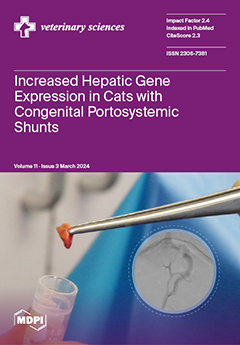The effect of vitamins and minerals supplementation (VTM) and/or two rates of body weight gain (GAIN) on bovine placental vascular development and angiogenic factors gene expression were evaluated in two experiments: In Exp. 1, crossbred Angus heifers (
n = 34) were assigned to VTM/NoVTM treatments at least 71 days before breeding to allow changes in the mineral status. At breeding, through artificial insemination (AI), heifers were assigned to low-gain (LG) 0.28 kg/d or moderate-gain (MG) 0.79 kg/d treatments, resulting in NoVTM-LG (Control;
n = 8), NoVTM-MG (
n = 8), VTM-LG (
n = 9), and VTM-MG (
n = 9) until day 83 of gestation; In Exp. 2, crossbred angus heifers (
n = 28), were assigned to control (CON;
n = 12), receiving a basal total mixed ration (TMR) or TMR + VTM (VTM;
n = 16) from breeding until parturition. Placentomes from Exp. 1 and cotyledons (COT) from Exp. 2 were evaluated by immunohistochemistry for COT vascular density area. COTs from Exp. 1 were evaluated for angiogenic factor (
ANGPT-1,
ANGPT-2,
eNOS2,
eNOS3,
FLT1,
KDR,
TEK,
VEGFA) gene expression. In Exp. 1, COT vascularity was not affected by the interaction of VTM and GAIN (
p = 0.67) or the main effects of VTM (
p = 0.50) and GAIN (
p = 0.55). Likewise, angiogenic factors were not differentially expressed between treatments (
p < 0.05). In Exp. 2, COT vascularity was greater in VTM vs. CON (
p = 0.07). In conclusion, there is a suggested later-stage influence of vitamin and mineral supplementation on placental vascularity, emphasizing the importance of supplementation beyond early pregnancy.
Full article






